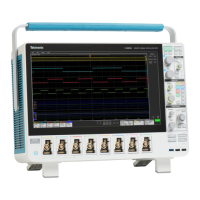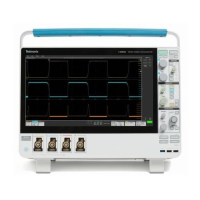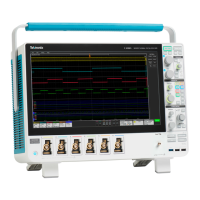Spectral math waveforms
The math capabilities of the instrument include waveform spectral analysis. This section describes how you can control the
analysis intuitively with time domain and frequency domain controls. These controls merge the time domain controls with the
frequency domain controls to provide a complete spectral analyzer.
Signals may be represented by their characteristics in both the time and the frequency domain. By combining and transforming
source waveforms into spectral math waveforms, you can simultaneously view signal characteristics in both domains.
This spectral analyzer provides a complete set of controls and features that allow you to make time and frequency domain
measurements without the need to learn extensive details about FFT algorithms.
■
Frequency Domain Controls. Use traditional spectrum analyzer controls to set the center frequency, span, and resolution
bandwidth directly.
■
Time Domain Controls. The time domain controls for the acquired waveform set the time duration and the resolution (time
between samples). You can easily set the required sample rate and record length.
■
Gating Controls. These controls are the bridge that connects the time domain to the frequency domain. You can perform
spectral analysis on a gated region of the input waveform. This gating also determines the resolution bandwidth.
■
Window Functions. Eight different window functions are available to shape the filter response.
■
Magnitude Versus Frequency. Displays log data in dB, dBm, or linear mode. You can display the real or imaginary parts of
the spectral magnitude only. Reference level offset and reference level controls give complete control over the vertical
position and offset of the spectrum.
■
Phase Versus Frequency. Displays phase data as a function of frequency in radians or degrees. You may zero the noise
phase for magnitudes below a threshold level. Finally, you may select Phase unwrap and dq/dw, group delay.
■
Spectral Averaging. You can turn on averaging in the frequency domain for phase and magnitude waveforms.
■
Multiple Analyzer Control Locks. Up to four spectral analyzers can be used simultaneously. They can all be assigned to
different gates on the same source waveform or to different channel sources. The controls of Math1 and Math2 can be
locked, and the controls of Math3 and Math4 can be locked. When controls are locked, turning a control on one analyzer
changes the control on the other analyzer to the same value. Other combinations of locking, including all four analyzers, are
available using GPIB commands.
The same exclusions for math waveforms apply to spectral math waveforms. In addition, sources for spectral math waveforms
must be channel waveforms.
What do you want to do next?
Learn about using the spectral math controls.
Go to a step-by-step procedure for creating a spectral math waveform.
Spectral math controls
The spectral analyzer contains five primary control categories. These are shown in the table below.
Click one of the links for more information on using each type of control.
Oscilloscope reference
716 DPO70000SX, MSO/DPO70000DX, MSO/DPO70000C, DPO7000C, and MSO/DPO5000B Series

